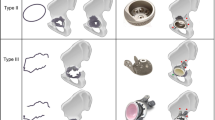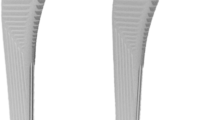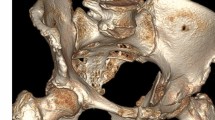Summary
A high incidence of acetabular loosening following total hip arthroplasty is emerging as long term follow-up studies become available. The Müller and Burch-Schneider acetabular supports are indicated for acetabular deficiencies which are frequently present during revision hip arthroplasty. The Burch-Schneider support is indicated where the deficiences are of such magnitude that the Müller ring does not have stable seating prior to screw fixation. These devices bring the resultant of forces across the hip joint under the acetabular roof and provide metal backing for the acetabular cup. They have the additional advantage of screw fixation which in the Müller ring is in line with the resultant of forces across the hip joint. In a one to three year follow-up of twenty-five hip replacements in twenty-four patients, the Müller support ring was used in twenty hips and the Burch-Schneider in five hips. The results were satisfactory and indicate that these supports are valuable in the treatment of patients with acetabular deficiencies.
Zusammenfassung
Ein häufiges Vorkommen von Pfannenlockerungen bei Hüftgelenk-Totalprothesen wird erkennbar, seitdem Langzeitbeobachtungen zur Verfügung stehen. Die Pfannen-Verstärkungsringe von Müller und Burch-Schneider sind indiziert bei mangelhaften Verankerungsbedingungen im Acetabulum, wie sie bei Prothesenauswechslungen häufig vorkommen. Der Burch-Schneider-Verstärkungsring ist angezeigt, wenn die Schädigung des Acetabulums so hochgradig ist, daß der Müller-Ring vor der Verschraubung keinen festen Halt findet. Diese Verschraubungsringe lenken die auf das Hüftgelenk einwirkenden Kräfte unter das Pfannendach und geben außerdem der Prothesenpfanne eine Metallverstärkung. Sie haben den zusätzlichen Vorteil der Schraubenfixation, wobei bei dem Müller-Ring die Schrauben in der Richtung der resultierenden Kräfte verlaufen, die auf das Hüftgelenk einwirken. In einer einbis dreijährigen Verlaufsuntersuchung von 25 Hüftgelenkprothesen bei 24 Patienten wurde der Verankerungsring von Müller bei 20 Hüften und der von Burch-Schneider bei 5 Hüften verwendet. Die Ergebnisse waren zufriedenstellend und zeigen, daß diese Verstärkungsringe bei mangelhaften Verankerungsbedingungen im Acetabulum wertvoll sind.
Similar content being viewed by others
References
Andersson C, Freeman M, Swanson S (1972) Loosening of the cemented acetabular cup in total hip replacement. J Bone Joint Surg [Br] 54:590–599
Charnley J (1979) Low friction arthroplasty of the hip. Springer, Berlin Heidelberg New York
Crownshield RD, Brand R, Pedersen D (1983) A stress analysis of acetabular reconstruction in protrusio acetabuli. J Bone Joint Surg [Am] 65:495–499
DeLee J, Charnley J (1976) Radiological demarcation of cemented sockets in total hip replacement. Clin Orthop 121:20–32
Eichler J (1973) Über einen Stützring zur Verankerung der Kunstoffpfanne für die operative Behandlung der Protrusio acetabuli. Med Orthop Techn 93:28–31
Hardinge K (1982) The direct lateral approach to the hip. J Bone Joint Surg [Br] 64:17–19
Harris WH (1969) Traumatic arthritis of the hip after dislocation and acetabular fractures: treatment by mold arthroplasty. J Bone Joint Surg [Am] 51:737–742
Harris WH, Jones WN (1975) The use of wire mesh in total hip replacement surgery. Clin Orthop 106:117–121
Hastings DE, Parker SM (1975) Protrusio acetabuli in rheumatoid arthritis. Clin Orthop 108:76–83
Indong OH, Harris W (1982) Design concepts, indications and surgical technique for use of the protrusio shell. Clin Orthop 162:175–188
McBroom R, Mueller M (1983) Aseptic loosening—fifteen years' experience with the Mueller total hip arthroplasty. Canadian Orthopaedic Association Meeting, Quebec
Pauwles F (1976) Biomechanics of the normal and diseased hip. Springer, Berlin Heidelberg New York
Schatzker J (Unpublished data)
Schatker J, Horne JG, Summer-Smith G (1975) The effect of movement of the holding power of screws in bone. Clin Orthop 111:257–262
Schatzker J, Hastings D, McBroom R (1979) Acetabular reinforcement in total hip replacement. Arch Orthop Trauma Surg 94:135–141
Schatzker J, Sanderson E, Murnaghan J (1975) The holding power of orthopaedic screws in vivo. Clin Orthop 108:115–126
Sutherland C, Wilde A, Borden L, Marks K (1982) A ten-year follow-up of one hundred consecutive Müller curved stem total hip replacements arthroplasties. J Bone Joint Surg [Am] 64:970–982
Wagner H (1962) Neue Osteosyntheseschrauben und ihre Gewebserträglichkeit. Verh Dtsch Orthop Ges 49:418
Author information
Authors and Affiliations
Rights and permissions
About this article
Cite this article
Schatzker, J., Glynn, M.K. & Ritter, D. A preliminary review of the Müller acetabular and Burch-Schneider antiprotrusio support rings. Arch. Orth. Traum. Surg. 103, 5–12 (1984). https://doi.org/10.1007/BF00451312
Received:
Issue Date:
DOI: https://doi.org/10.1007/BF00451312




